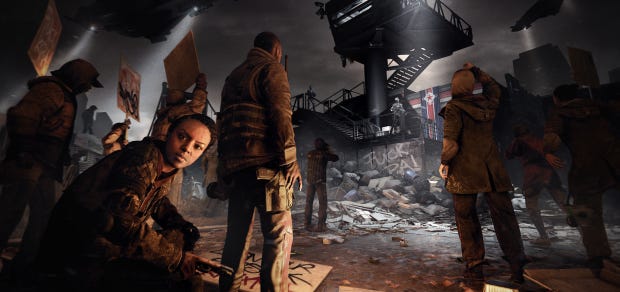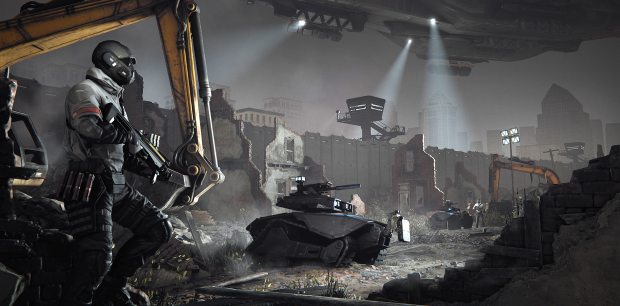First Look: Homefront - The Revolution
The Philadelphia Experiment
I'm not sure how a Homefront sequel that I didn't really care about became a Crysis game that I really want to play, but that's what I saw the other day. Homefront: The Revolution is Crysis. Hilariously Crysis. So very very Crysis. And yet it's a Crysis game that Crytek haven't even managed to make, despite having all the component parts.
Now they are, and it's a Homefront game. I am confused.
Perhaps the Korean element is all that was needed? Crysis had Koreans, and in the Homefront universe North and South Korea have come together to take control of the US, subjugating the population with remote control tanks and superior technology. The Revolution starts in a basement in Philadelphia.
I can't tell you if what I saw accurately portrayed Philly, but it did look nice. From the cluttered basement, where a phone call alerts the player to trouble outside, we walk out to the birthplace of American independence. The city is in layers: we're in a shanty town where the subjugated population sits beneath the Whitman bridge, and higher up the rot gives way to technological barnacles. In the sky are drones and ships scanning the world below, homing in on dissent for the ground troops to suppress. It has the same quality of City 17, where the old world is a scaffolding holding up the oppressors. Crytek UK is aiming for density and interactivity, not a gigantic world.
But it is big and lively, and my brain immediately questions what I'm looking at. The original Crysis was a sandbox, but it wasn't an open world, and the original Homefront was just a big, silly shooter that dragged you through by your nosehairs. What the hell is going on?
David Stenton, Crytek UK's Homefront's producer, sidles up and explains: "The game is set within Philadelphia, a dystopian Philadelphia, occupied by the KPA. It opens up through the course of the game. As you progress according to story as and you acquire new abilities, the game world will grow in accordance as you progress through the game. It's seamless, so you can travel back and forth seamlessly between different areas--it's really necessary to do that. "
Why? Because they're building a world where you decide what targets to hit, and you need to choose carefully because you won't always be strong enough to fight targets. You're helped by a mobile phone packed with apps. You know the binoculars in Crysis? The phone plays that part in Homefront, enabling you to tag and track enemies and camera, and leading you to caches of weapons that the militia has stashed. The player, a revolutionary named Ethan Grady, selects a cache that's in an alleyway where a beating is taking place. It's necessary to stealthily dispatch the beaters to get to the cache, and even inside the abandoned store he's ducking from scanners poking through the broken window. Of course it's a demo, so he dodges and moves on, bringing the explosives he found with him. The target is a police station.
I'm not going to talk about the shooting too much: it is very Crysisy, and the guns have a modability that enables a rifle to swap from silent to a room clearing ear-popper. It's the set-up that's more interesting. The station is a tense place: it's the focal point of a queue of civvies in numbers that makes the KPA nervous. They might have overwhelming firepower and technology, but the resistance has mobility and ingenuity: Ethan hits his inventory and pulls out an RC and straps an IED to it. He guides the car through the crowd and under a KPA patrol vehicle, then nudges it forwards when the vehicle enters the yard. Dialling up the bomb creates mayhem that scatters the crowd and starts the battle between you, your small team who've been co-ordinating, and the KPA.
And then there are shootybangs. I'm more interested in the world and the place and the structure of the game, and luckily David Stenton has some answers: "The attack on the police station, if you can imagine that maybe at certain points in the game that attack on the police station is too difficult, maybe you don't have the RC car, the IED? If you didn't happen to have those, if you can't build those at that point in the game, maybe you come across the police station, and you take a look at it and scout around it from different angles, and you think: 'Well, it's too difficult for now.'
"And then you go back to previously visited areas, to other zones, you can walk there, fast-travel there. It's a seamless world you inhabit, so it's really necessary to go to other parts of the game world, get new abilities do missions, then maybe come back with the RC car and IED, and that's your chosen strategy to take on that objective. "
That's also true of the co-op game, btw. It's set in the same world and framework, though it's separate from the single-player progress. Wandering the world sounds fascinating, especially as there's the promise of inter-AI interaction. InterAIction, if you will. The growing resistance and the KPA will be constantly provoking each other, allowing for moments where the pressure drives the action rather than the story.
According to Stenton: "One of the big things we're trying to push with Homefront is we really want to give people that immersion that you are within an occupied, oppressive society, and you're objective within that is to choose those targets of opportunity to rise up: 'I observe the systems. Where do I choose to commit those acts of resistance and try and push back on the KPS occupation?'
"Activities that occur that are of interest as part of this living game, oppressive game world. One of these ghetto districts that civilians are rounded up into is called the 'Collaborator's District', and this is an area where US citizens that are in league with the KPA, they collaborate with the KPA for better food, for better rations, for better accommodation, you can engage with those.
"Wherever possible, we always try to bring things together. You're living in this oppressed game world. What are the different systems, what are the politics of living within that game world? What are people's problems? And we try to get involved. Some of those requiring direct action--sabotage and gunplay--and some of them not requiring necessarily direct action. "
Of course, I've seen almost none of this in action. Just a snippet of a fight, and a few city streets. But Crytek has always promised to make this sort of game, and it might as well be in a series that doesn't have aliens or freezing tech. The oddball purchase of Homefront, turning it into a stealth Crysis game and getting the former Free Radical team to make it for them, might just be their way of fulfilling that promise.















